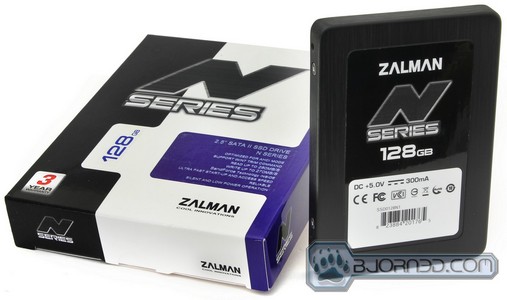Zalman surprised us with their latest N Series SSDs, proving to be one of the top performer SSDs on the market from our collection of 20+ SSDs. With the SandForce SF-1222 chip, Zalman hit the perfect spot for excellent performance and capacity at an affordable price point.
Introduction
We never thought that Zalman, a company so renowned for their silent cooling solutions, would ever come out with SSDs for performance users and enthusiasts. Though SSDs work silently, we would have never thought that Zalman would get into the flash memory storage market to sell SSDs. Zalman launched several drives ranging from 32GB to 128GB, and our sources tell us that Zalman will have 256GB drives in the future. The new Zalman SSDs come in 2 different series, the ‘S’ series, which are tailored for the entry level SSD users with a JMICRON controller, and the ‘N’ series, which are designed for enthusiasts and performance users using the new SandForce SF-1222 controller.
S Series
- SSD0032S1 – 32GB – $99.99
- SSD0064S1 – 64GB – $149.99
- SSD0128S1 – 128GB – $249.99
N Series
- SSD0064N1 – 64GB – $169.99
- SSD0128N1 – 128GB – $289.99
From what we have heard, Zalman will be monitoring the competition and will make sure that their own SSDs will be even more affordable than other SSDs on the market. The prices above are the MSRP prices from last month, but actual prices might vary when they become available for ordering.
Features & Specifications
|
|||||||||||||||||||||||||||||||||||||||||||||||||||||||||||||||||||||||||||||||||||||||||||||||||||||||||||||||||||||||||||
|
|||||||||||||||||||||||||||||||||||||||||||||||||||||||||||||||||||||||||||||||||||||||||||||||||||||||||||||||||||||||||||
The Zalman S and N Series SSDs come with Trim support. The problem with current SSDs is that when data is written to them, it stays permanent on the flash memory till a secure erase is performed. Unfortunately, deleting the files or formatting the Solid State Drive is not enough. As long as the information is recorded on the SSD, when a delete command is executed on the SSD, the delete command does not go through the SandForce controller, but instead just marks the memory that the previous files can be overwritten the next time files are added to the drive. Because of this, the SSD has to go through a delete and then write process when new files are added to the pages where files were located before. Trim support allows the drive to actually go through the process of cleaning the deleted files off of the memory pages after a delete command is executed. To do this, the drive first receives a request to read an entire block of data where the pages needed to be deleted are located, and then moves the data to the cache memory where it removes the unnecessary pages and rewrites it back to the previous block. This process is supposed to bring back the performance that users see when they first install their SSDs. Drives that have the Trim command usually cost a lot more than other Solid State Drives that done have it.
An overview of SSD’s
SSD, as most already know, stands for Solid State Drive, which means no moving parts to generate noise or wear out. Currently, they use Nand Flash technology, of which there are two types: SLC (Singe Level Cell) and MLC (Multi-Level Cell). Both SLC and MLC take up the same amount of space and the difference between the two is how the data is stored. First, let’s take a look at how a Nand Flash Cell is set up.

Each individual cell is actually a transistor with the form pictured above. Each cell can hold one bit of data. The user writes to the cell by electron tunneling, applying the correct amount of voltage to the gate, and electrons tunnel through the oxide into the floating gate. Applying the voltage to the channel instead of the gate reverses the bias, and electrons go the other way. Nand Flash has two states, 1 and 0. When the user turns off the power, the data remains, so it’s great for even long-term storage. The data should remain in pristine condition without power for 10 years if 10% of the drive’s normal lifespan has already been used. MLC drives are rated for 10,000 cycles. If the user has read and written data (Programmed and Erased) to the drive 10,000 times, which is the expected life cycle of each cell, then the data should last a year. The life cycle of SLC Solid State Drives is 100,000 cycles. With SLC, one bit of data is written to one cell and with MLC, two bits of data are written to each cell. While users get more storage with MLC for the same space and the same number of cells, it’s harder on the cells to store and retrieve information information that way. “Why didn’t they just make SLC drives?” SLC drives are twice as expensive to make because they require one cell for every “bit” of data. In effect, MLC drives store twice the information at half the cost, which is why they are less expensive than SLC drives.
SLC vs MLC
What are the main differences between the SLC and MLC drives? The two main differences between SLC and MLC are lifespan, and data storage method. We need another graphic here.

In an SLC drive, there are only states 0 and 1, off and on (two voltages). In an MLC there are states 11, 10, 01, 00 (4 voltages). It takes longer to access the MLC cell because it has more data in it and the drive controller has to be more careful with it not to write the wrong data. It’s the same minimum and maximum voltages as the SLC cell uses, but the MLC has more graduations between the minimum and maximum voltages. This affects performance somewhat. We need a table to show that.
| SLC NAND flash | MLC NAND flash | |
| Random Read | 25 µs | 50 µs |
| Erase | 2ms per block | 2ms per block |
| Programming | 250 µs | 900 µs |
When the cell is being erased they have the same performance. It takes twice as long to read an MLC as it does to read an SLC, which makes sense because it contains twice as much data. Writes (Programming) can take almost four times as long. So even though they use the same Nand Flash transistor, it takes twice as long to read from the MLC as it does to the SLC, and four times as long to program an MLC as it does an SLC. The SLC lasts 10 times as long as an MLC (100,000 cycles vs 10,000 cycles). That lifespan difference because the MLC stores twice as much data per cell.
Life Span
How do we define the lifespan of a drive? We’ve been talking about cycles. A cycle is comprised of one read and one write to one cell. SLC lasts 100,000 cycles, MLC lasts 10,000 cycles.
How The Cells Are Arranged
A group of cells together comprises a page. A page is the smallest block can be written to, and is 4KB in size. After a page comes a block. A block is comprised of an amount of pages. In an Intel MLC, a block is comprised of 128 pages (4×128 – 512KB). Users can write to a single page within the block. To erase a page, users have to erase the block (512KB) that the page is part of. This saves wear and tear on the drive’s cells. Say we write a 12KB file to the drive, which then needs to be deleted. The 12KB file is saved as 3 pages. When we go to erase it, if the block of 128 pages isn’t full, it just marks the 3 pages as invalid, sort of like a regular hard drive does with a file. On a regular hard drive, unless the drive space the file is in is wiped, the file is really still there. In that case, the drive just knocks off the first letter of the file name and replaces it with a “?” and the operating system stops displaying the file. The same principle applies with an SSD. The file is marked with a “?” and is erased at an efficient time (when the whole block needs to be erased).
Is The SSD Going To Fail On Me Like The Thumb Drive Did?
We suspect most SSD’s are designed with a fail safe system that will inform users well in advance that the drive will fail. The nice part about this is that the SSD knows exactly which cells it can and can’t write to, and it has a cell leveling algorithm that makes sure the cells are used about the same amount, meaning that the drive uses intelligent programs and electronics to ensure no one set of cells is used any more than another. Otherwise, some cells would get heavier use and fail quicker than others. That begs the question, if one cell fails, does the whole drive die? The answer is no. The drive keeps a certain amount of blocks in reserve, not allocated to the advertised drive space and uses them as blocks fail.
Pictures & Impression
When the Zalman N Series SSD arrived, it was much lighter than what we expected. We’ll check out the inside of the box in a second to see why it was so light. The box has a black and blue design, and shows whether the drive is the S or N series SSD. The box also shows the capacity of the SSD as well as the main features that the SSD comes with, including the maximum read and write speeds, the SandForce controllers with the Trim command. The box also comments that the drive is a reliable, silent operation with low power consumption. The back of the box goes into more detail about the size form factor, and the built in ECC and wear-leveling technology, as well as anti-shock properties that SSDs have.
Now when we opened up the box, everything seemed fine, till we actually took out everything that was included in the box. We’ll go into more detail about that on the next picture. From the first picture we can see that the SSD is put into a shock absorbent transparent plastic cover, which helps prevent damage to the SSD if the box falls down from a shelf or during shipment.
So when we mentioned that we were a bit puzzled why the box was so light, we came to realize that the box only included the SSD and a quick installation guide. In previous SSDs that we reviewed, we found that several drives, like the Kingston SSDNow drives, come in two different forms: the Laptop version and the Desktop version. The Laptop version comes with the SSD, a software CD, and an external USB 2.5″ enclosure which users can put the old HDD into for easier cloning. The Desktop version comes with the SSD, a software CD, SATA cable, some screws, and a 2.5″ to 3.5″ mounting unit, so users can easily mount their SSD into a hard drive bay. Unfortunately, the Zalman SSDs are currently only shipped with a quick installation guide. We would have like to see some software or mounting accessories bundled with the drive.
The Zalman S and N series SSDs come in a very nice black anodized brushed aluminum housing. This design is excellent for making sure the SSD stays extremely light, and also for heat dissipation. The front sticker shows the drive series, the capacity, and several specifications and tests the drive passed. If we do a bit of math, 5V x 0.3A equals 1.5W of power. This is extremely low compared to actual 7200RPM hard drives, which use around 7-10W of power. Those hard drives usually perform around 3 times slower than the Zalman N Series 128GB SSD. The back of the SSD has the clear black anodized brushed aluminum design as well. We can see the SATA data and power connector as well.
We decided to open up the SSD for a closer look at the PCB design and the controller that it uses. From the first picture we can see the well known SandForce SF-1222 controller. This controller is mainly used on high performance SSDs, so we are expecting high performance from this drive. From taking a look at both sides of the PCB, the we can see a total of 16 Intel branded 34nm MLC NAND flash memory modules with the 29F64G08CAMDB part number. These are 8GBs each, adding up to a total of 128GBs of storage.
Finally, here is the cover of the Zalman SSD. We can see that towards the bottom, there are two parts where the PCB screws onto the cover. On the top part of the casing is some soft foam cushioning for shock resistance. Since SSDs don’t have any moving parts, they not only silent, but are also harder to break. With the extra soft foaming inside the enclosure of the SSD, the PCB is protected above and beyond what is necessary. This is a nice addition from Zalman.
Testing Methodology
To test the Zalman N Series SSD, we installed Windows 7 Professional on it along with all the applications that a standard PC would use. We have also placed Music, Pictures, and Videos on it to simulate the real-life personal use that a user would use the SSD for. Windows 7 has also been fully updated to the latest version along with other software. To get accurate readings however of the true performance of the drive, we have disabled all background applications, besides what Windows 7 Pro already comes with. This way nothing that may affect the outcome of the testing procedure can interfere. We ran all of the tests a total of 3 times and averaged those results. The Average of the three results are presented here. In the case of a pictorial benchmark we ran the bench 3 times and picked the median result. As with most SSDs, testing differences from run to run are minimal and the median result is a good indication of what you can expect from the drive.
We ran our usual battery of tests on the drive, and used it as the primary boot drive during testing. All of the drives tested were used as the primary boot drive during testing. That’s a more realistic test than strapping the drive in and testing it with a bare format or as a non-boot drive, and it represents real life transfer rates, much like you can expect when you install and operate the drive in your own system. Each test was performed 3 times and the average of the 3 test run is reported here.
Almost all tests are measured in MB/s, and in general higher numbers are better than lower, unless otherwise stated in the charts. For latency tests measured in ns, lower numbers are better.
Test Rig
| Test Rig | |
| Case | Silverstone Temjin TJ10 |
| CPU |
Intel Core i7 930 @ 3.8GHz |
| Motherboard |
ASUS Rampage III Extreme ROG – LGA1366 |
| Ram |
OCZ DDR3-12800 1600MHz (8-8-8-24 1.65v) 12GB Triple-Channel Kit |
| CPU Cooler | Thermalright True Black 120 with 2x Zalman ZM-F3 FDB 120mm Fans |
| Storage |
4x Seagate Cheetah 600GB 10K 6Gb/s Hard Drives 2x Western Digital RE3 1TB 7200RPM 3Gb/s Hard Drives 1x Zalman N Series 128GB SSD – SSD0128N1 |
| Optical | ASUS DVD-Burner |
| GPU |
ASUS GeForce GTX 580 Voltage Tweak |
| Case Fans |
2x Zalman ZM-F3 FDB 120mm Fans – Top 1x Zalman Shark’s Fin ZM-SF3 120mm Fan – Back 1x Silverstone 120mm fan – Front 1x Zalman ZM-F3 FDB 120mm Fan – Hard Drive Compartment 1x Zalman ZM-F3 FDB 120mm Fan – Side Ventilation for Video Cards and RAID Card SAS Controller. |
| Additional Cards |
LSI 3ware SATA + SAS 9750-8i 6Gb/s RAID Card |
| PSU |
Sapphire PURE 1250W Modular Power Supply |
| Mouse | Logitech G5 |
| Keyboard | Logitech G15 |
Test Suite
The following applications were used to test the performance of the SSDs in our results.
|
Benchmarks |
|
ATTO |
|
HDTach |
|
Crystal DiskMark |
|
HD Tune Pro |
|
AS SSD Benchmark |
ATTO
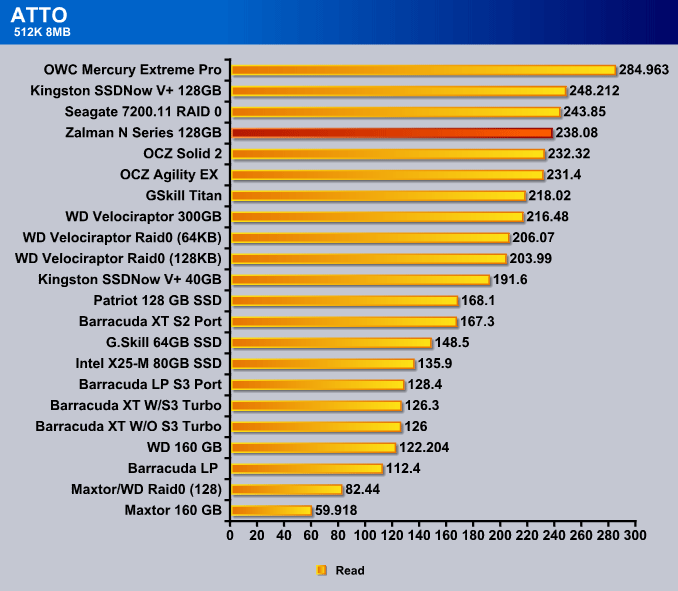
The first test shows some great numbers for the Zalman N Series 128GB SSD as compared to the other two top performer SSDs, the Kingston SSDNow V+ and OWC Mercury Extreme Pro SSD. We can see that the Seagate 7200.11 RAID 0 setup is a bit faster than the Zalman N Series 128GB drive, but comparing SSDs to SSDs, the Zalman N Series 128GB Solid State Drive comes in third.
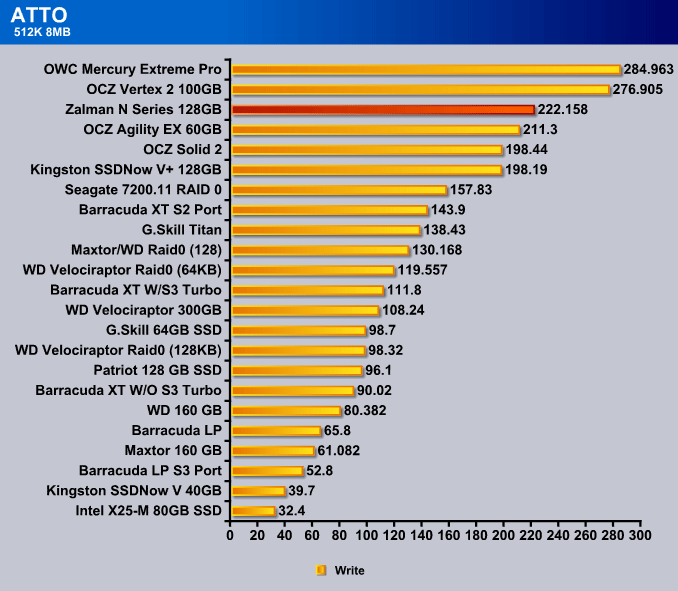
The write speed of the Zalman N Series 128GB SSD still allowed it to be in third position compared to a lot of other SSDs, but we can see that the OCZ Vertex 2 and the OWC Mercury Extreme Pro have about 50-60MB/s higher performance than the Zalman SSD. The OCZ Agility EX 60GB SSD comes in about 11MB/s slower than the Zalman N Series 128GB SSD.
AS SSD
AS SSD is an infant in the benchmark world and has been going through enough revisions that we just use screen shots of it. Trying to chart performance on a benchmark that is being changed weekly is a little pointless but since it’s written specifically for SSD’s we are including it. As we can see in the pictures, by the time we received the Zalman SSD, there was a new version out again, but we went ahead and compared the results anyway.
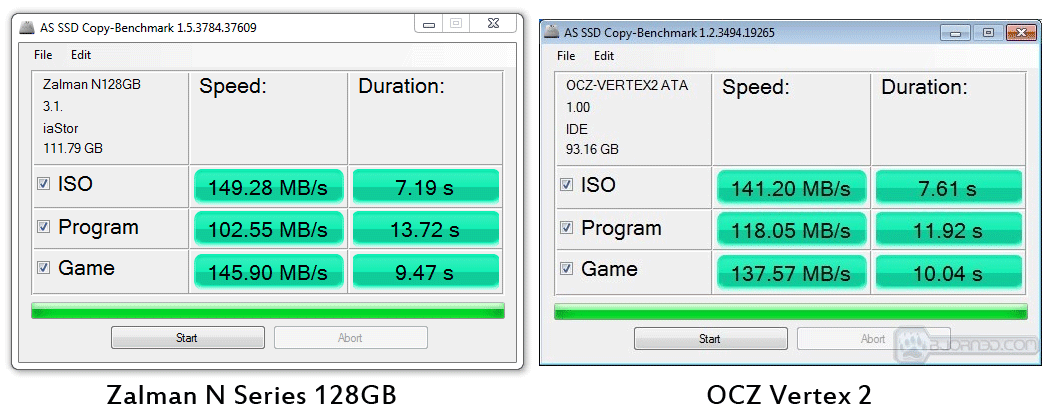
The Copy portion of AS SSD give us a little more realistic look at speed than raw benchmarks of a synthetic nature. In the copy portion we got 149.28 MB/s for ISO’s, about 8MB/s faster than the OCZ Vertex 2. The program sections shows us 102.55 MB/s and the gaming section shows 145.90 MB/s. So we can see the Zalman N Series 128GB SSD performed slightly slower on the Program benchmark but faster on the Game benchmark than the OCZ Vertex 2. We’ve actually run platter drives on this benchmark and they take hours, whereas SSD’s finish in mere minutes (1 – 3 minutes).
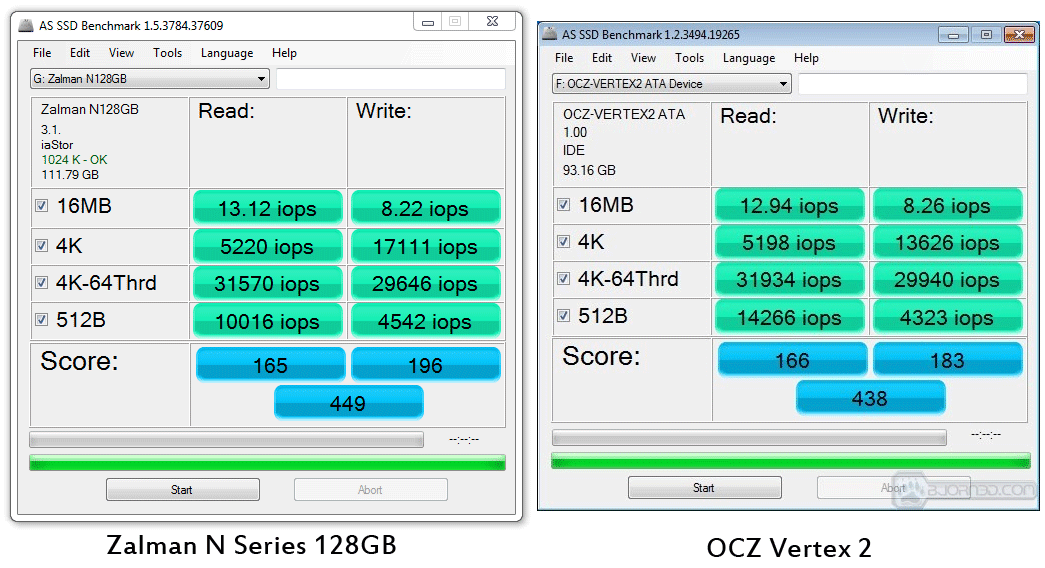
The important section of the IOP’s test in this case is the 4k-64k Threaded. Most drives we’ve seen hit 5k in the 4k or 4k-64k Threaded threaded, with considerable effort. The Zalman SSD and the OCZ Vertex 2 blow that out of the water, hitting around 29 – 32k in the 4k – 64k Threaded tests. The OCZ Vertex 2 performed slightly higher than the Zalman SSD, however the performance difference should be minimal.
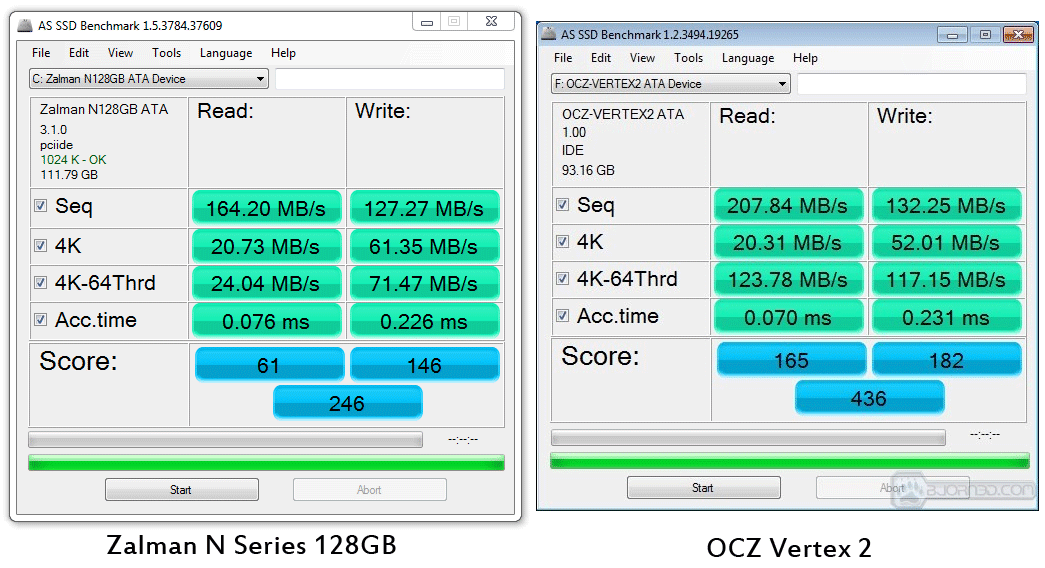
From the final tests, speed benchmarks show us that the OCZ Vertex 2 does indeed excel at 4k and 4k – 64k Threaded testing even when compared to the Zalman N Series 128GB SSD. A lot of other drives we’ve seen top out at 32 MB/s, but here we see a top end of 117.5 MB/s Write for the OCZ Vertex 2 and 71.47 MB/s Write for the Zalman SSD.
CrystalDiskMark
Towards the tail end, there are some benchmarks that were performed on the Crystal DiskMark 2.2 and 3.0 versions. These benchmarks are only the 4k benchmarks. We have a clear description of the drives that use the 2.2v and the 3.0v for easier understanding.

The Zalman SSD is about 20MB/s slower than the OCZ Vertex 2 SSD, and about 50MB/s slower than the OCZ Agility EX SSD. At the same time the Zalman SSD is hanging on tight with the other high performing SSDs on the market right now.
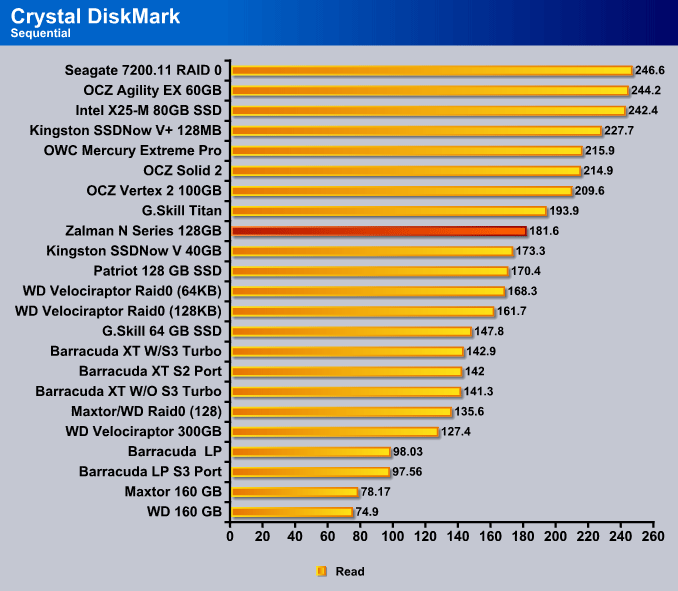
The Zalman SSD hangs on tight once again in the Crystal DiskMark Sequential benchmark, but this time in the Read benchmark. We can see that there is a bigger performance difference between the SSDs than we have seen in the Write benchmark. The Zalman SSD still seems to be a bit better performer than the midrange SSDs that we have tested, and about 60MB/s slower than the OCZ Agility EX 60GB SSD.

On the 512K tests, where platter hard drives and other SSDs seem to start struggling at is where the Zalman N Series 128GB SSD starts to shine again. There is a big difference between the performance of the OCZ Agility EX and the Zalman SSD, but there is a also huge difference between the OCZ Agility EX and the other SSDs, so the Zalman SSD is still holding up quite nicely.
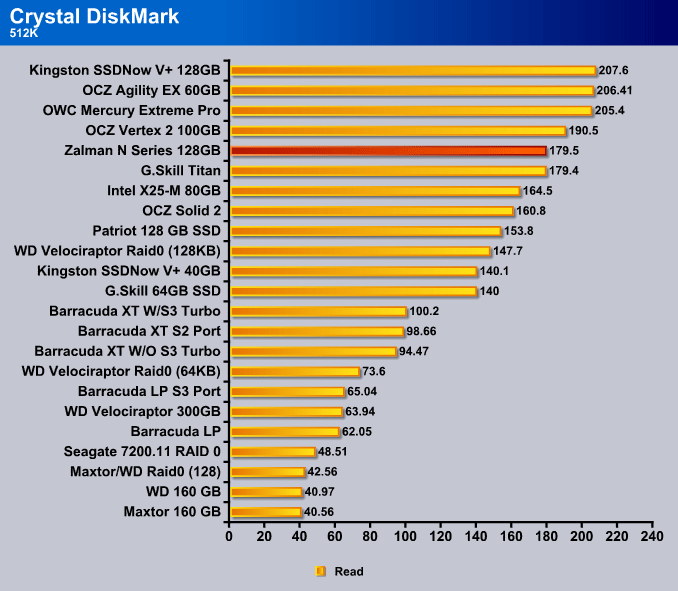
Here we can see the performance drop that we were talking about on the platter drives. The Zalman SSD came in 5th in this benchmark, but not too far behind from the fastest SSD for the 512K Read benchmark, the Kingston SSDNow V+ 128GB SSD.
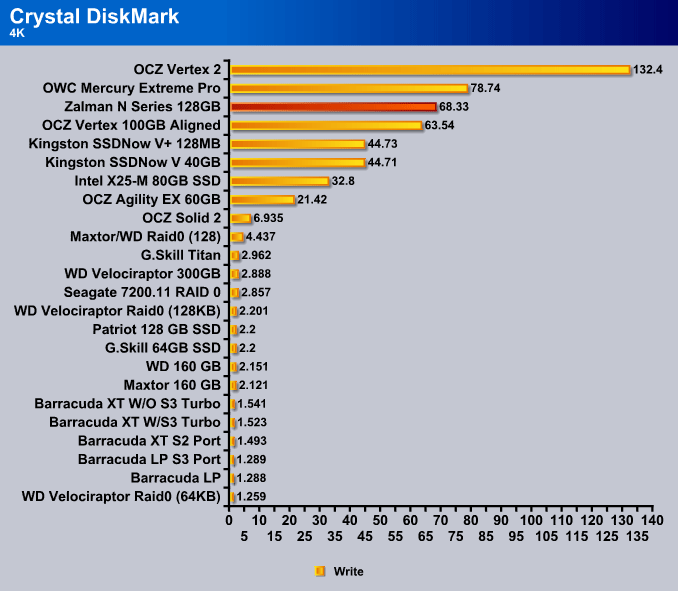
Here’s where we are using CDM 2.2 and 3.0. Keep in mind that since they are different versions this is somewhat of an Apples to Oranges in comparison. The Zalman N Series 128GB SSD was tested on the 2.2v without the performance decrease that we saw on the other SSDs. This shows just how nicely the Zalman N Series 128GB SSDs perform in the small 4K benchmarks where platter hard drives and even SSDs get slaughtered.

The Zalman SSD was ran on the 2.2 version once again, and it was almost able to get first place. It shows phenomenal performance increase in read from the other drives tested.
Hd Tune Pro
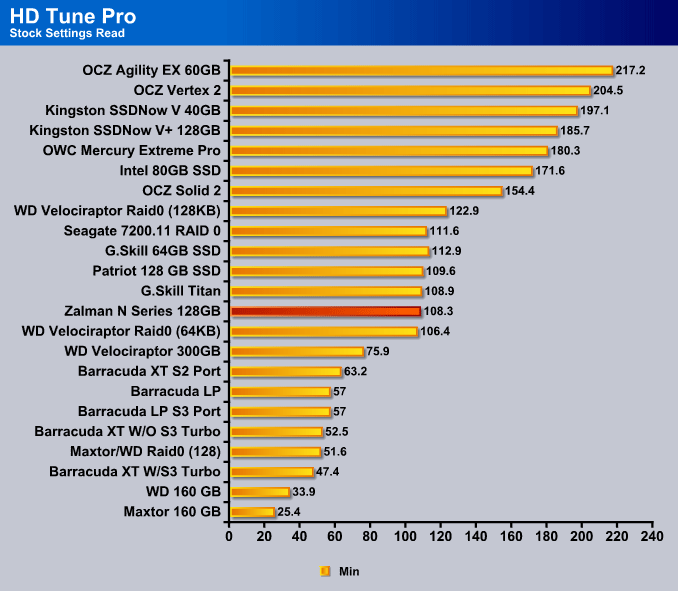
The minimum performance of an SSD is somewhat questionable in benchmarks. There was only one tiny section during the benchmark where the SSD reached 108.3MBs, while all the other sections were ranging at around 180MB/s.
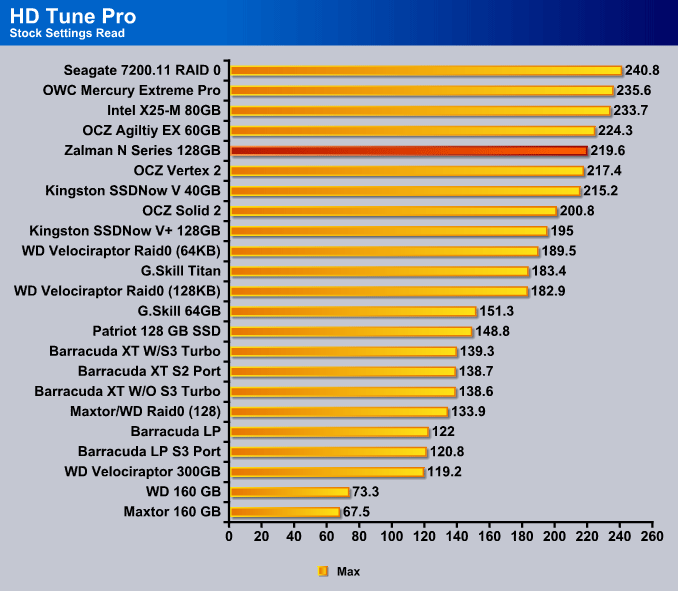
Max performance on the other hand is a better way of comparing SSDs when it comes to total performance. We can see that a Seagate 7200.11 RAID 0 configuration grants the user with the highest performance, and that there are only 3 other SSDs that beat the Zalman N Series 128GB SSD. We found this very impressive.
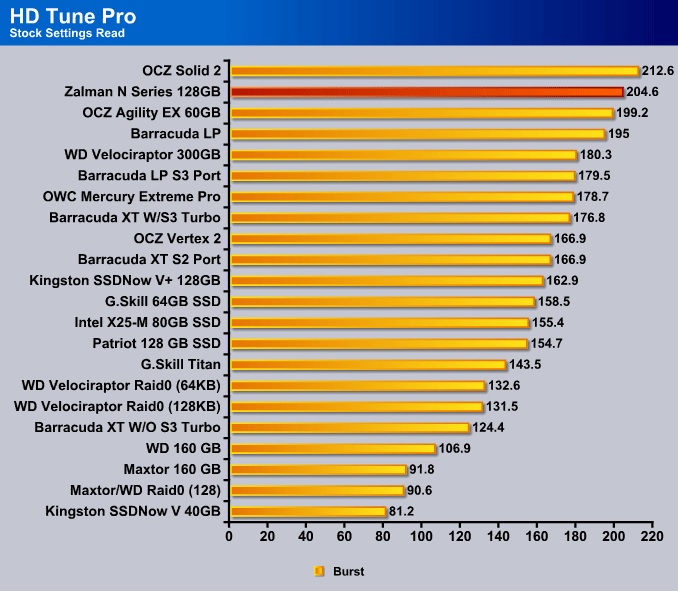
While Burst speed can effect performance of files being read or written to a drive, these speeds once again are usually not a good way of comparing SSDs to each other. We have included the results just so our readers would get an idea of what to expect from each SSD.
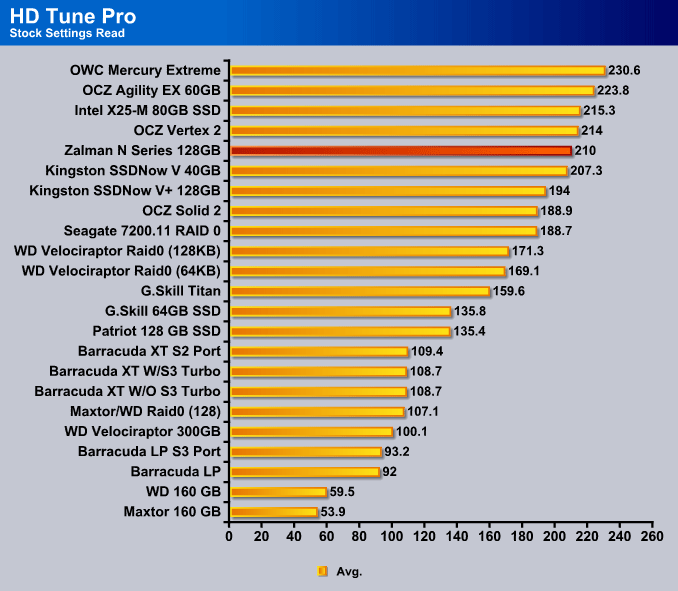
The Average performance of a SSD is the most important in our opinion. The Zalman N Series 128GB SSD came in on the top once again, and this shows that it does have quite a bit of performance compared to its price and the capacity that it comes in. There was only a 20MB/s read speed difference between the OWC Mercury Extreme and the Zalman N Series 128GB SSD.
HDTach

HDTach is one of our favorite benchmarks because it always provides us with accurate performance readings across the wide range of SSDs we have tested in the past. As far as SSDs go, the Zalman SSD was only 12MB/s behind the OCZ Vertex 2 SSD, and there were only 3 SSDs that were faster than the Zalman N Series 128GB SSD.
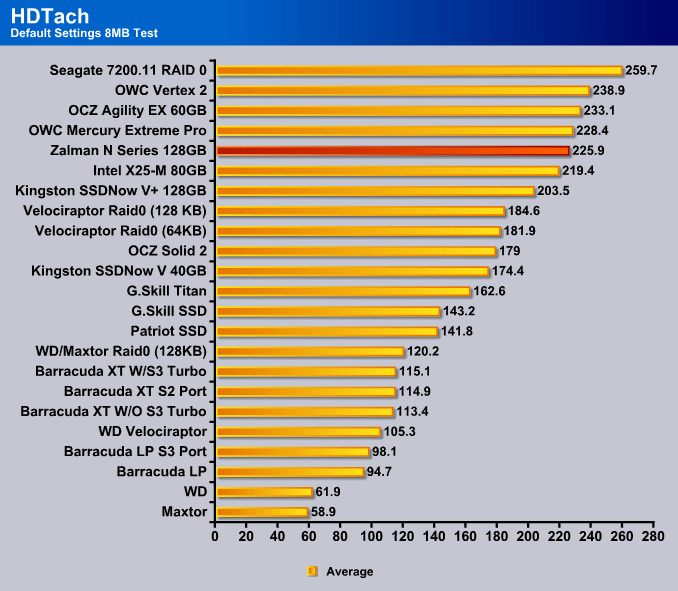
The slowest SSD in our test, the Patriot SSD, it was about 80MB/s slower than the Zalman SSD, and the fastest SSD, the OWC Vertex 2 was only about 13MB/s faster than the Zalman SSD. Overall, while the Zalman SSD doesn’t top these tests, it does have a very high performance compared to other SSDs and platter drives. Additionally, the difference between the Zalman SSD and the one that did top the test is very small. We can see great potential in the Zalman N Series 128GB SSDs.
Conclusion
The Zalman N Series 128GB SSD has impressed us in many ways, however it also left us asking for a bit more. While the Zalman N Series 128GB SSD comes with lots of nice features like support for Trim commands, high read and write speeds with the SandForce SF-1222 controller, and cool and silent operation, we feel that Zalman should have put a bit more time into making sure the SSD also comes with a good accessory package. We feel that if Zalman would have went the route that Kingston went, by providing accessories for their desktop and laptop SSD models, it would have made a better package for the price. Though we think that the price is superb for the performance and storage capacity that the Zalman N series SSDs offers, its competitors have a better package. For instance, the Kingston SSDNow V+ series SSDs ranges in the same price as the Zalman N series SSDs and performs close to that of the Zalman N series SSDs, but the Kingston package also comes with SATA power and data cables, Desktop mounting hardware, as well as cloning software.
On the other hand, we were extremely pleased by the low power consumption vs. performance of this drive, not to mention that it is completely silent and generates almost no heat. The black anodized brushed aluminum housing is also excellent for dissipation of heat and making sure the drive is extremely light. The inside of the housing also had some very nice soft foaming to prevent the SSD from getting damaged when it gets thrown around, which makes this SSD even more anti-shock resistant than some SSDs we have tested in the past.
Editor’s Opinion:
I had the good fortune to see this product personally, as the reviewer is a close friend of mine. I was amazed by its light weight and sturdiness. From what I saw, it was a good product, though apparently lacking in its bundle. I would certainly have liked to some sort of mounting mechanism included with this drive, as a lot of cases don’t fit SSD’s. Nonetheless, it is a good product for the end user to consider. This is especially considering that SSD’s are becoming more and more mainstream, and the age of rotating platter drives is slowly but surely coming to an end. Considering that this is Zalman’s first foot into the SSD race, it’s a great start, and it has great implications for the end user.
| OUR VERDICT: Zalman N Series 128GB SSD | ||||||||||||||||||
|
||||||||||||||||||
| Summary: With the Zalman N Series 128GB SSD proving to be one of the higher performing SSDs on the market at the moment, the MSRP of $289.99 is still not too bad to make this SSD a decent choice for performance users, especially because of the SF-1222 (SF-1200) controller, very low power consumption and silent operation. The Zalman N Series 128GB SSD deserves a 8 out of 10 points and the Bjorn3D Silver Bear Award. |
 Bjorn3D.com Bjorn3d.com – Satisfying Your Daily Tech Cravings Since 1996
Bjorn3D.com Bjorn3d.com – Satisfying Your Daily Tech Cravings Since 1996

